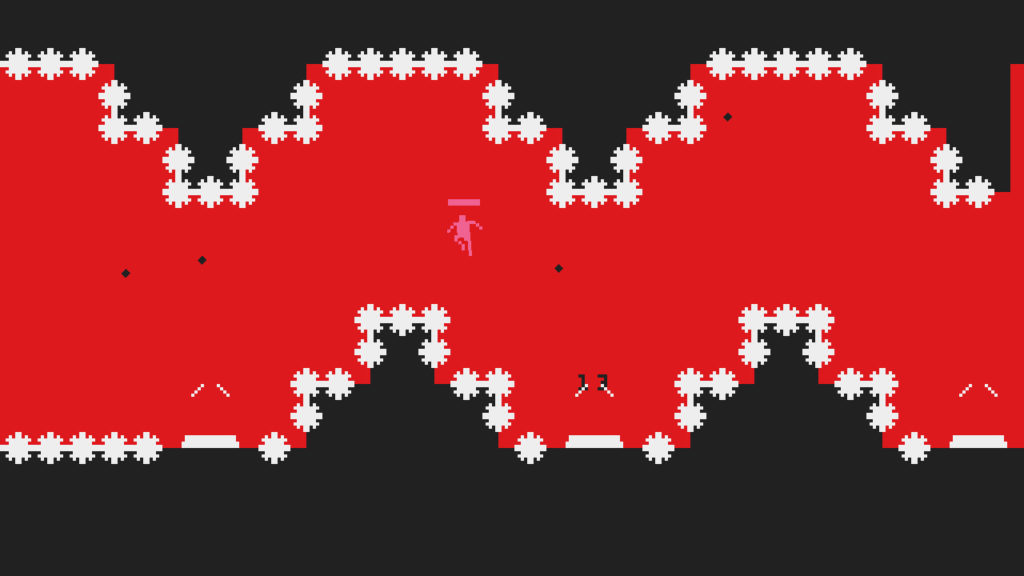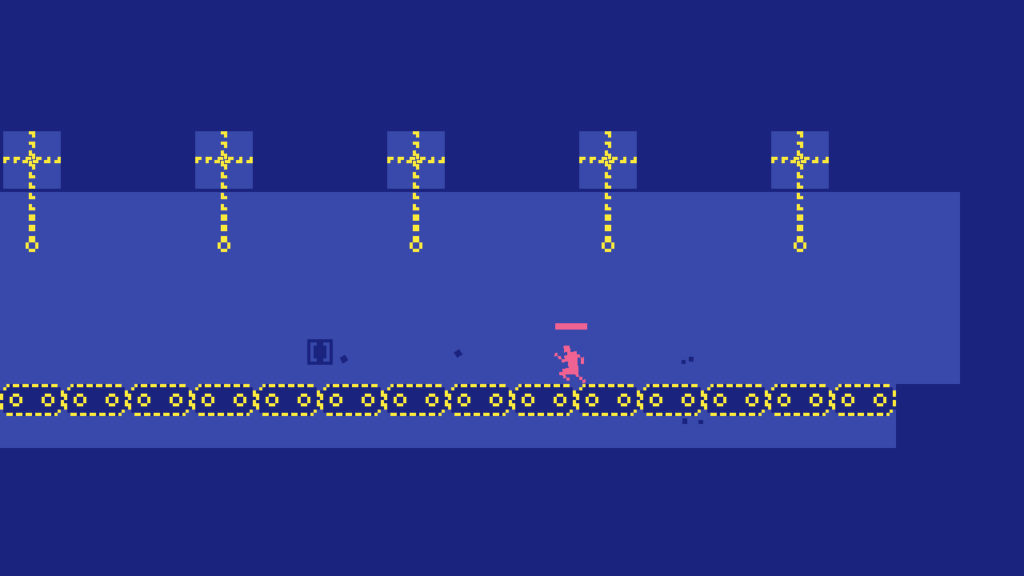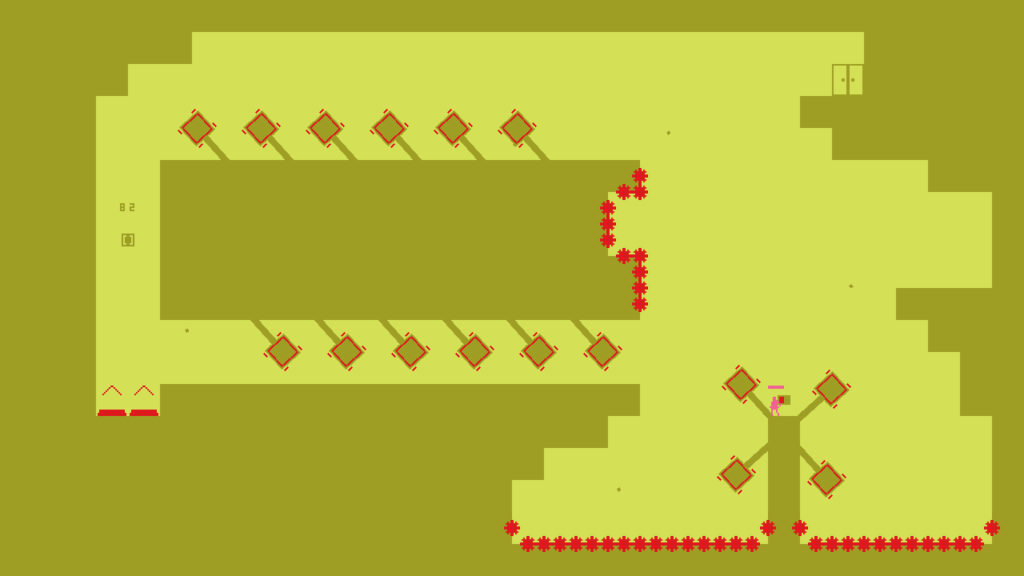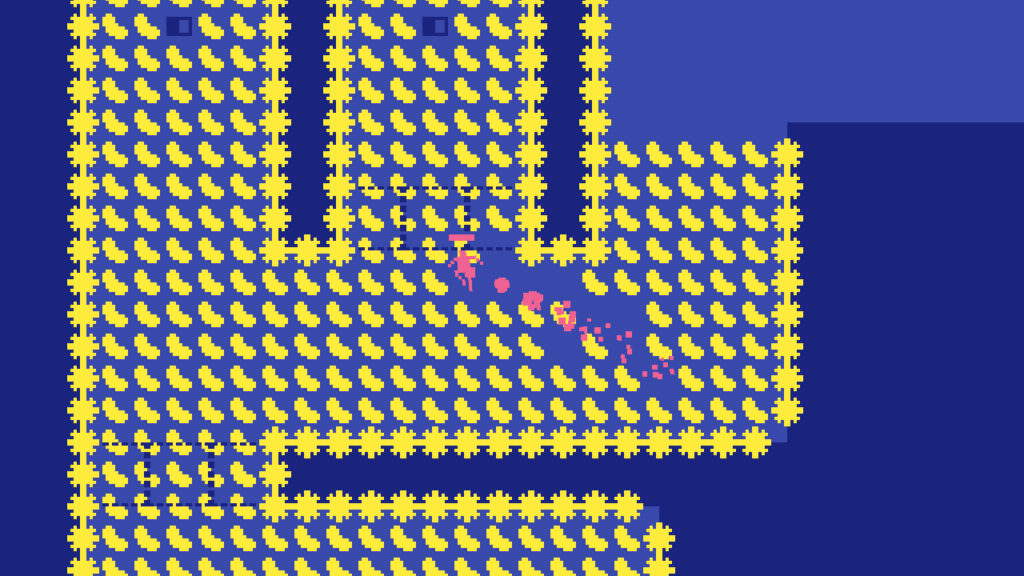Pinkman is a fast, stylish platform where you run, jump, and fart (yes, really) your way through 100 short levels. Between the focus on rocket launchers, the laser turrets, the sleek, minimalistic graphics, and the ultimate goal of flipping switches to open exit doors there seems to be a fair amount of influence from the N series at work here, but Pinkman goes beyond being a clone by taking these elements and combining them with new mechanics (like farting) with the end result being a game which can stand on its own merits.
There’s no story within the game itself and that’s entirely fine because the most important thing here is the raw gameplay experience. The controls, as simple as they are, are wonderfully smooth and precise with running, wall jumping, and even hovering through the air via farts all flowing together seamlessly. This sense of smoothness is in part thanks to the camera, which is zoomed in just far enough to allow for plenty of precision while still giving you a good idea of your surroundings. If you need to move through a long corridor or simply want a better idea of where everything is in a level, then you can also instantaneously toggle the camera to zoom out to show the entire level at once. The only issue here is that the game never tells you about the existence of this zoom-out feature despite using the first few levels to teach players about the rest of the controls; I only discovered how to adjust the camera’s zoom (for the record, it’s the ‘C’ key on the keyboard by default) largely by accident after reaching the end of the game on my first playthrough and a small tip addressing this feature early on would have definitely made some of the later levels much easier.

Farting may be a rather silly, somewhat embarrassing defining characteristic for our protagonist, but it’s also quite an important mechanic. Overall, this is more or less a quirky take on a standard jetpack power. After jumping or falling off a ledge you can extend your time in the air by depleting your fart meter. Holding down the button will give you a small vertical boost before the meter runs out, which is often needed to reach platforms or to make it back to safety after jumping into a pit to flip a switch. However, this power is very versatile as tapping the button can allow it to serve as a break to greatly slow your momentum while falling or being flung upward and you’ll often need to rapidly tap the button in order to hover through horizontal spike corridors. Though there are no permanent upgrades in Pinkman, the utility granted by this ability is somewhat expanded upon starting with the 25th level with the introduction of (what else?) beans which fully restore the fart meter upon touching them to allow you to cover much larger vertical and horizontal distances. The fart meter itself drains rapidly while in use, but it also refills after about a second of not using it. The refill mechanic sometimes leads to a break in the otherwise fluid sense of momentum as you wait for the bar to fill, which can feel jarring no matter how short that break may be, though these instances are uncommon and largely occur in the early levels when the game is still partially focused on teaching players.

If the smooth gameplay is the most important part of Pinkman, then the sheer degree of variety is certainly the most impressive. In a game with 100 levels, a new element is added in every fifth level, making for a rather large list of enemies, objects, and environmental hazards. This new addition to the formula is sometimes a new enemy, such as turrets which launch heat-seeking rockets or a ghostly, glitchy doppleganger which ceaselessly follows you through walls, but more often than not it’s a fairly neutral type of environmental object, such as switches to open doors or warp portals. Unfortunately, this does mean that the new mechanics introduced in levels 90 and 95 don’t get much time to shine before the end of the game, but that is definitely not the case for the other elements. Ideas aren’t just introduced only to be thrown away the moment something new makes an appearance, they are built upon and constantly combined in new ways, such as by making the player outrun one of those dopplegangers while navigating a maze of fake wall tiles with a few holes in the illusion to hint at the true path.

The sense of gameplay variety may be impressive enough on its own, but what really makes Pinkman stand out is the variety of ways in which all of these elements are actually used within the level design. Sure, laser turrets and electrical hammers are always going to be dangerous, but the less directly deadly objects are truly neutral in nature. This sense of creative usage can first be seen as early as level 10 when jump pads are introduced. While the first jump pad is used in the expected manner to boost you up to a very high ledge, this is immediately followed by a series of jump pads which must be avoided while descending down a vertical shaft as touching them will send Pinkman flying straight into some spikes. Within a matter of seconds the game instantly and effectively displays how easily useful objects can be turned into traps. Of course, the jump pads are only the first of many such objects. Switches can open doors, but they can also drop the floor out from beneath your feet so you can reach the unique switch which opens the exit door, crumbling blocks can make the platforming more demanding, but they also sometimes form more slow-paced mazes where you need to carefully create a path through them while avoiding spikes, conveyor belts can either make platforming more difficult or they can help you outrun a rocket, and so on. Even the rotating electrical hammers prove themselves to be useful for blocking projectiles once or twice. It’s one thing to have a high amount of gameplay variety, but Pinkman goes above and beyond by using each element to its fullest potential.

There are a few features which I wish were included here, though at the current, ridiculously modest asking price of $0.99 players are still easily getting their money’s worth of entertainment from Pinkman. The most obvious missing feature in a game which seems to otherwise be so heavily geared towards being speedrun-friendly is the lack of leaderboards. Finishing a full run of the game lets you see your time, but there isn’t an online leaderboard and this number isn’t even recorded on a local level by the game. You can also freely select to replay any of the stages you’ve already completed, but an individual stage timer is also missing and you don’t get to see a preview of the stage before selecting it, which can result in needing to jump in and out of multiple stages if you are looking for a specific one. Other than speedrun features and stage previews, a level editor would have also fit well here, especially since the inclusion of one would have allowed for players to experiment more with the late-game elements, though I suppose one can always hope for the inclusion of a level editor as a form of DLC or in a sequel.
Even though the package may be light on additional bells and whistles, the core experience is rock solid with smooth controls and absolutely phenomenal level design all for less than a single dollar. Yes, Pinkman is definitely a game worth buying.